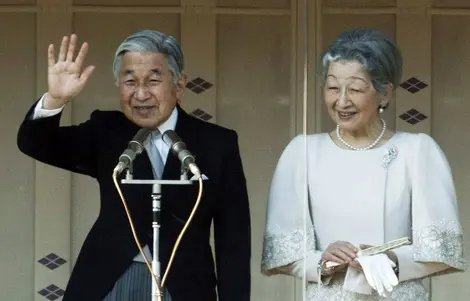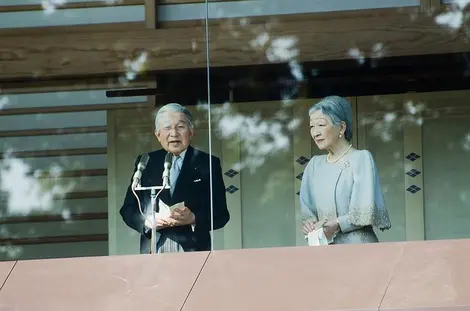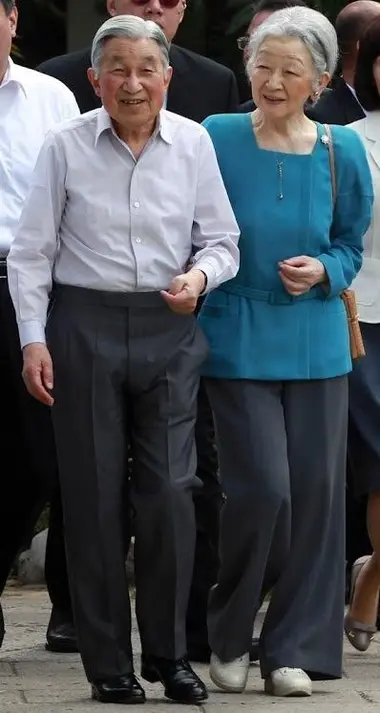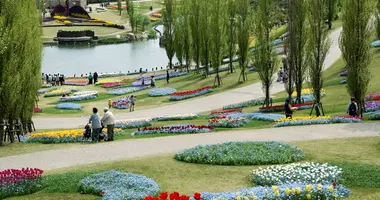The abdication of the Emperor of Japan 天皇退位
The end of an era
On April 30th, 2019, Emperor Akihito will give up his symbolic role. Look back on his reign and the path to his abdication.

The Imperial family
Impressive lineage
The Japanese imperial throne, nicknamed the "chrysanthemum throne", is supposedly the oldest dynasty in the world. According to legend, the first emperor Jinmu would have reigned from 660 BC. On February 11th each year, Japan celebrates the advent of the first emperor, in accordance with the legend written in the Nihon Shoki, a historical work dating from 720 that tells of the origins of the imperial family. This day is called kenkoku kinen no hi (the founding day of the Japanese state).
While the Emperor of Japan had to give up his divine status after the constitution introduced during the American occupation, he still maintains a symbolic role. By embodying the imperial lineage, the emperor symbolizes the nation and the unity of the Japanese people. He is also the supreme priest of Shinto. However, he is not to intervene in matters of government and does not interfere in politics.
Akihito, a "modern" emperor
Born on December 23rd, 1933, the current emperor has been in office since the death of his father on January 7th, 1989. He will therefore be abdicating after 30 years of reign on the chrysanthemum throne. Although known as Akihito in the West, he is called "His Majesty the Emperor" (Tenno Heika) by the Japanese people, because using the emperor's name after his coronation is considered a deeply disrespectful.
Having benefited from the teachings of two British tutors and a liberal economist, Akihito developed more modern ideas and opened Japan up to the world. He was also surrounded by Catholic tutors who contributed to the modernization and desecration of the throne, without having any religious influence on the emperor. This is what led him to marry a commoner, a first in the imperial family history. This union was not unanimously supported, the mother of Akihito being one of the most fervent opponents of the marriage.
Breaking the strict codes of the imperial house, the couple decided not to entrust their children to nannies and tutors, and decided to raise them themselves. Leading a modern and Western lifestyle, the Emperor took part in household chores and in 1986 was even the first member of the imperial family to use the metro system! Over the years the couple made visits to all 47 prefectures of the country to get closer to the Japanese people.
Akihito also made statements that broke the rules of the constitution stating that the emperor shouldn't speak on political and societal affairs. But he spoke as a citizen rather than as Emperor of Japan on several topics - he apologized personally to the people of Asian countries that suffered from the cruelties perpetrated during their Japanese occupation. On the occasion of the 70th anniversary of the end of the Second World War, he also expressed "deep remorse".
Giving up the throne
In 2016 rumors began to circulate that due to health concerns, the Emperor of Japan would like to abdicate. But the Imperial Agency immediately refuted this, since the constitution only allows a transfer of power on the death of the emperor in office. But on August 8, 2016, Akihito directly addressed the Japanese people in a public statement to express his doubts about his ability to fulfill his duties as emperor. It was his second televised official statement, the first one following the terrible earthquake and tsunami of 2011.
The government reached an agreement and on May 19th, 2017, a bill applicable only to the current emperor was approved, authorizing him to abdicate. Akihito is the first emperor to abdicate in 200 years, but it was a common practice until the 19th century! The date was decided in December 2017 to be April 30th, 2019, so after 30 years of rule, the 125th Emperor of Japan will give up his throne. He will be 85 years old.
His eldest son, Naruhito, the Crown Prince and now 58 years old, will take over and become Japan's new Emperor on May 1st, 2019.
See also: The Emperor of Japan










